Travelodge Case Study: Structure, SWOT, PESTLE Analysis
VerifiedAdded on 2023/06/04
|9
|1979
|149
Case Study
AI Summary
This case study examines Travelodge, a prominent hospitality company, delving into its organisational structure, business environment, and strategic analyses. The study begins with an introduction to business organisations and then provides an overview of Travelodge, including its founding, headquarters, and market presence. The main body of the case study explores the company's hierarchical organisational structure, detailing its advantages like a clear chain of command and clear lines of communication, as well as its drawbacks, such as centralization of power. The business environment analysis includes a SWOT analysis, identifying Travelodge's strengths (attractive pricing, extensive presence), weaknesses (perceived as boring, overbooking issues), opportunities (global expansion, eco-friendly initiatives), and threats (competition, limited international presence). A PESTLE analysis then assesses the impact of political, economic, socio-cultural, technological, legal, and environmental factors on Travelodge's operations. The conclusion summarizes the key findings, emphasizing the importance of organisational structure and strategic analysis for the company's growth and success. Finally, references to books and journals are provided.
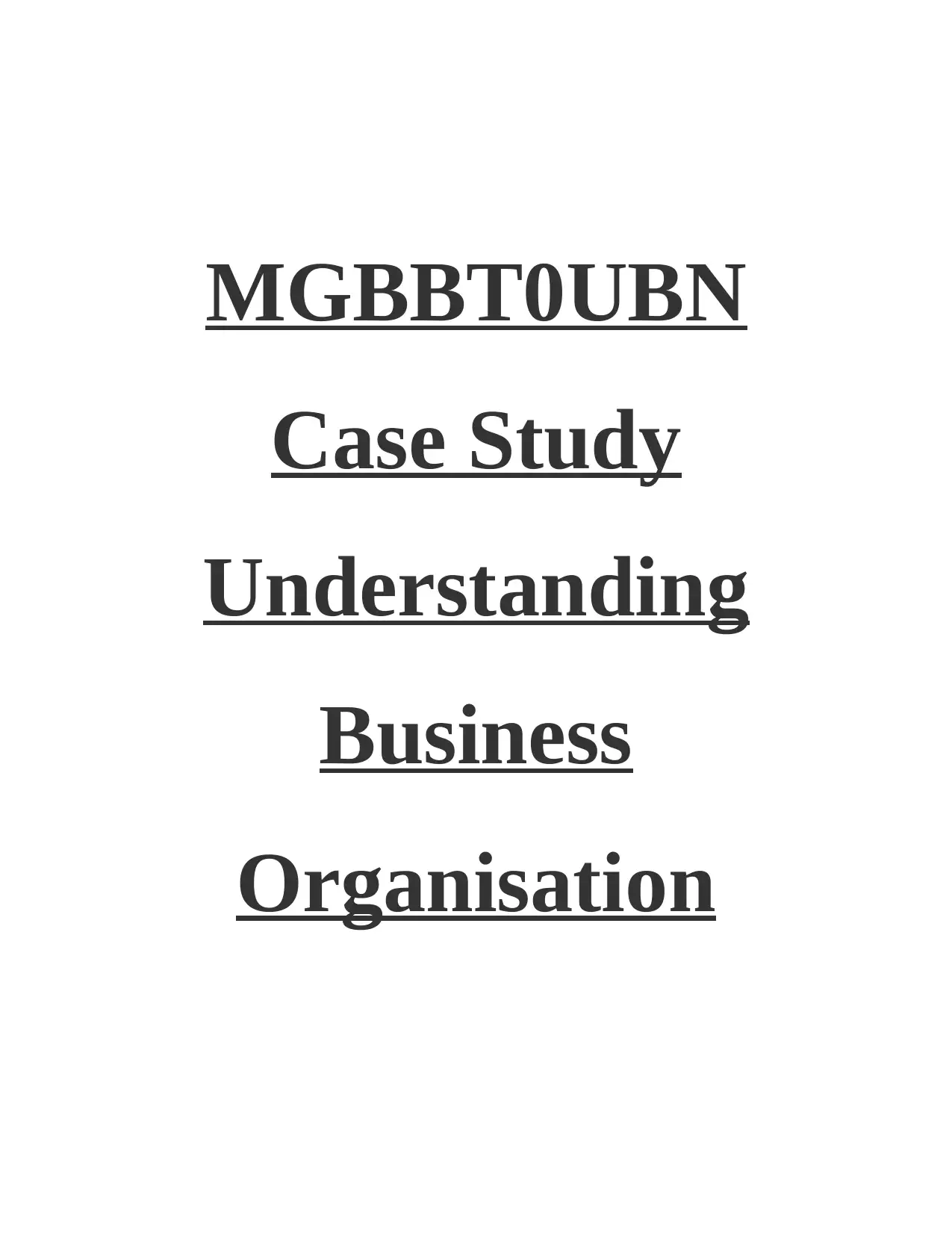
MGBBT0UBN
Case Study
Understanding
Business
Organisation
Case Study
Understanding
Business
Organisation
Paraphrase This Document
Need a fresh take? Get an instant paraphrase of this document with our AI Paraphraser
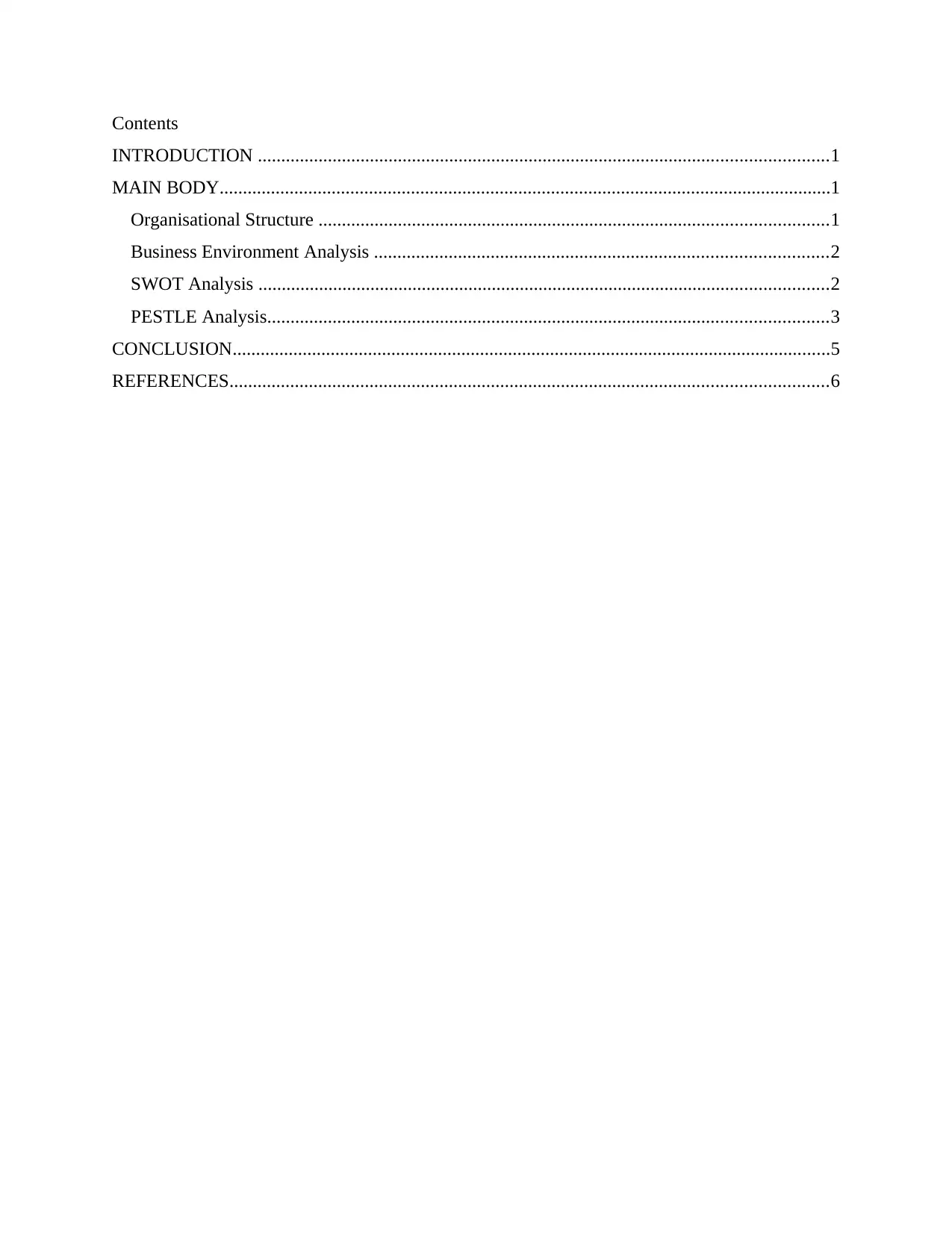
Contents
INTRODUCTION ..........................................................................................................................1
MAIN BODY...................................................................................................................................1
Organisational Structure .............................................................................................................1
Business Environment Analysis .................................................................................................2
SWOT Analysis ..........................................................................................................................2
PESTLE Analysis........................................................................................................................3
CONCLUSION................................................................................................................................5
REFERENCES................................................................................................................................6
INTRODUCTION ..........................................................................................................................1
MAIN BODY...................................................................................................................................1
Organisational Structure .............................................................................................................1
Business Environment Analysis .................................................................................................2
SWOT Analysis ..........................................................................................................................2
PESTLE Analysis........................................................................................................................3
CONCLUSION................................................................................................................................5
REFERENCES................................................................................................................................6
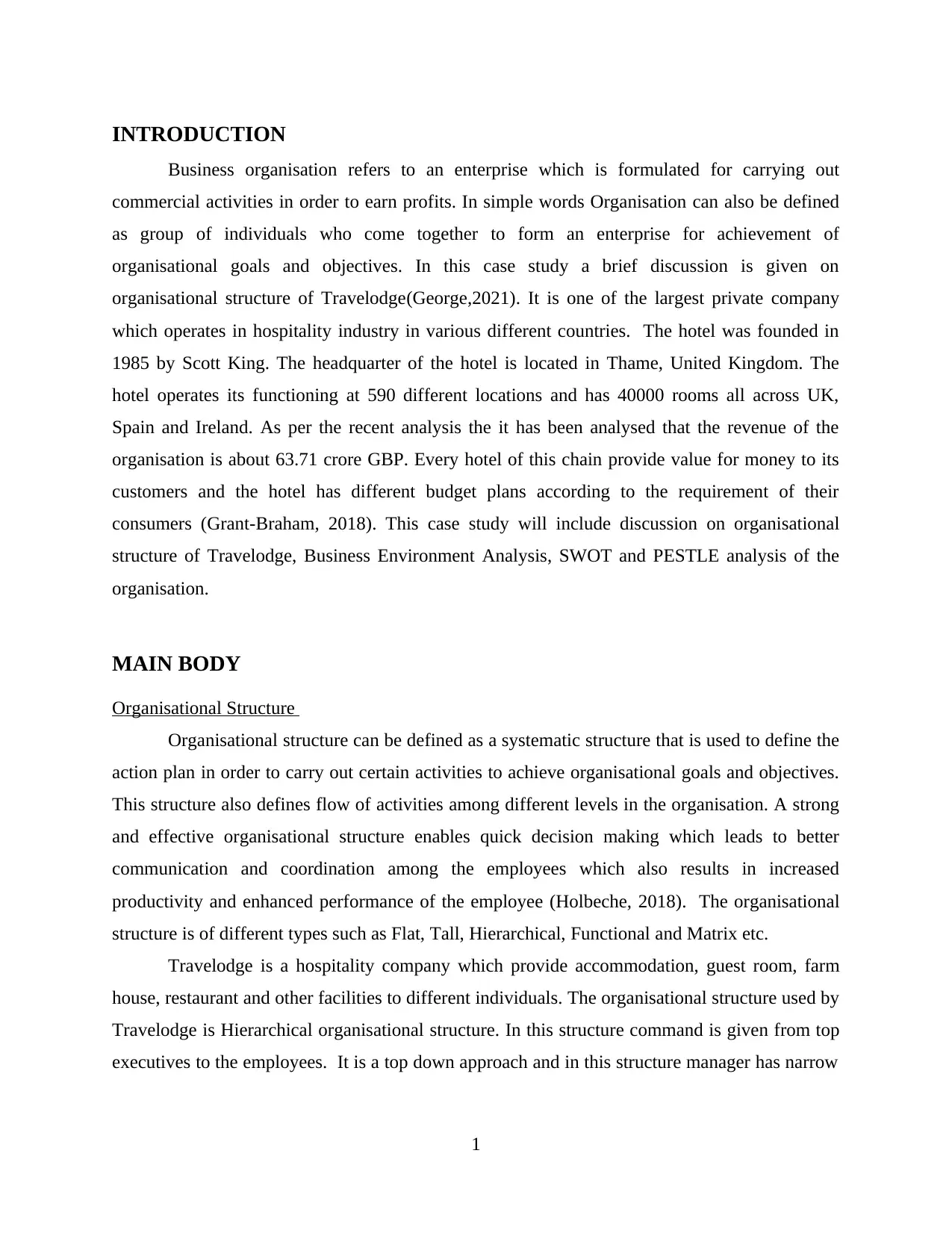
INTRODUCTION
Business organisation refers to an enterprise which is formulated for carrying out
commercial activities in order to earn profits. In simple words Organisation can also be defined
as group of individuals who come together to form an enterprise for achievement of
organisational goals and objectives. In this case study a brief discussion is given on
organisational structure of Travelodge(George,2021). It is one of the largest private company
which operates in hospitality industry in various different countries. The hotel was founded in
1985 by Scott King. The headquarter of the hotel is located in Thame, United Kingdom. The
hotel operates its functioning at 590 different locations and has 40000 rooms all across UK,
Spain and Ireland. As per the recent analysis the it has been analysed that the revenue of the
organisation is about 63.71 crore GBP. Every hotel of this chain provide value for money to its
customers and the hotel has different budget plans according to the requirement of their
consumers (Grant-Braham, 2018). This case study will include discussion on organisational
structure of Travelodge, Business Environment Analysis, SWOT and PESTLE analysis of the
organisation.
MAIN BODY
Organisational Structure
Organisational structure can be defined as a systematic structure that is used to define the
action plan in order to carry out certain activities to achieve organisational goals and objectives.
This structure also defines flow of activities among different levels in the organisation. A strong
and effective organisational structure enables quick decision making which leads to better
communication and coordination among the employees which also results in increased
productivity and enhanced performance of the employee (Holbeche, 2018). The organisational
structure is of different types such as Flat, Tall, Hierarchical, Functional and Matrix etc.
Travelodge is a hospitality company which provide accommodation, guest room, farm
house, restaurant and other facilities to different individuals. The organisational structure used by
Travelodge is Hierarchical organisational structure. In this structure command is given from top
executives to the employees. It is a top down approach and in this structure manager has narrow
1
Business organisation refers to an enterprise which is formulated for carrying out
commercial activities in order to earn profits. In simple words Organisation can also be defined
as group of individuals who come together to form an enterprise for achievement of
organisational goals and objectives. In this case study a brief discussion is given on
organisational structure of Travelodge(George,2021). It is one of the largest private company
which operates in hospitality industry in various different countries. The hotel was founded in
1985 by Scott King. The headquarter of the hotel is located in Thame, United Kingdom. The
hotel operates its functioning at 590 different locations and has 40000 rooms all across UK,
Spain and Ireland. As per the recent analysis the it has been analysed that the revenue of the
organisation is about 63.71 crore GBP. Every hotel of this chain provide value for money to its
customers and the hotel has different budget plans according to the requirement of their
consumers (Grant-Braham, 2018). This case study will include discussion on organisational
structure of Travelodge, Business Environment Analysis, SWOT and PESTLE analysis of the
organisation.
MAIN BODY
Organisational Structure
Organisational structure can be defined as a systematic structure that is used to define the
action plan in order to carry out certain activities to achieve organisational goals and objectives.
This structure also defines flow of activities among different levels in the organisation. A strong
and effective organisational structure enables quick decision making which leads to better
communication and coordination among the employees which also results in increased
productivity and enhanced performance of the employee (Holbeche, 2018). The organisational
structure is of different types such as Flat, Tall, Hierarchical, Functional and Matrix etc.
Travelodge is a hospitality company which provide accommodation, guest room, farm
house, restaurant and other facilities to different individuals. The organisational structure used by
Travelodge is Hierarchical organisational structure. In this structure command is given from top
executives to the employees. It is a top down approach and in this structure manager has narrow
1
⊘ This is a preview!⊘
Do you want full access?
Subscribe today to unlock all pages.

Trusted by 1+ million students worldwide
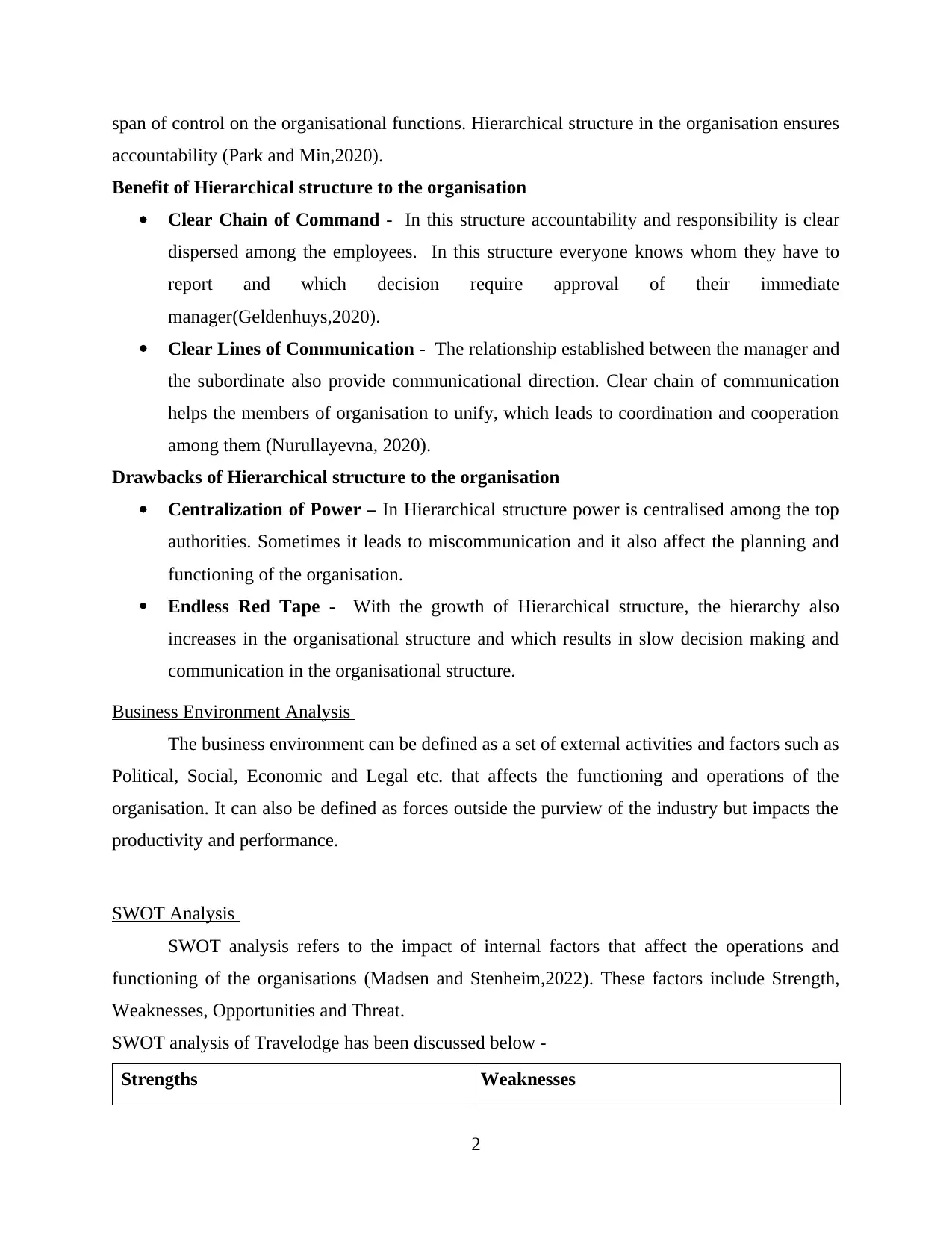
span of control on the organisational functions. Hierarchical structure in the organisation ensures
accountability (Park and Min,2020).
Benefit of Hierarchical structure to the organisation
Clear Chain of Command - In this structure accountability and responsibility is clear
dispersed among the employees. In this structure everyone knows whom they have to
report and which decision require approval of their immediate
manager(Geldenhuys,2020).
Clear Lines of Communication - The relationship established between the manager and
the subordinate also provide communicational direction. Clear chain of communication
helps the members of organisation to unify, which leads to coordination and cooperation
among them (Nurullayevna, 2020).
Drawbacks of Hierarchical structure to the organisation
Centralization of Power – In Hierarchical structure power is centralised among the top
authorities. Sometimes it leads to miscommunication and it also affect the planning and
functioning of the organisation.
Endless Red Tape - With the growth of Hierarchical structure, the hierarchy also
increases in the organisational structure and which results in slow decision making and
communication in the organisational structure.
Business Environment Analysis
The business environment can be defined as a set of external activities and factors such as
Political, Social, Economic and Legal etc. that affects the functioning and operations of the
organisation. It can also be defined as forces outside the purview of the industry but impacts the
productivity and performance.
SWOT Analysis
SWOT analysis refers to the impact of internal factors that affect the operations and
functioning of the organisations (Madsen and Stenheim,2022). These factors include Strength,
Weaknesses, Opportunities and Threat.
SWOT analysis of Travelodge has been discussed below -
Strengths Weaknesses
2
accountability (Park and Min,2020).
Benefit of Hierarchical structure to the organisation
Clear Chain of Command - In this structure accountability and responsibility is clear
dispersed among the employees. In this structure everyone knows whom they have to
report and which decision require approval of their immediate
manager(Geldenhuys,2020).
Clear Lines of Communication - The relationship established between the manager and
the subordinate also provide communicational direction. Clear chain of communication
helps the members of organisation to unify, which leads to coordination and cooperation
among them (Nurullayevna, 2020).
Drawbacks of Hierarchical structure to the organisation
Centralization of Power – In Hierarchical structure power is centralised among the top
authorities. Sometimes it leads to miscommunication and it also affect the planning and
functioning of the organisation.
Endless Red Tape - With the growth of Hierarchical structure, the hierarchy also
increases in the organisational structure and which results in slow decision making and
communication in the organisational structure.
Business Environment Analysis
The business environment can be defined as a set of external activities and factors such as
Political, Social, Economic and Legal etc. that affects the functioning and operations of the
organisation. It can also be defined as forces outside the purview of the industry but impacts the
productivity and performance.
SWOT Analysis
SWOT analysis refers to the impact of internal factors that affect the operations and
functioning of the organisations (Madsen and Stenheim,2022). These factors include Strength,
Weaknesses, Opportunities and Threat.
SWOT analysis of Travelodge has been discussed below -
Strengths Weaknesses
2
Paraphrase This Document
Need a fresh take? Get an instant paraphrase of this document with our AI Paraphraser
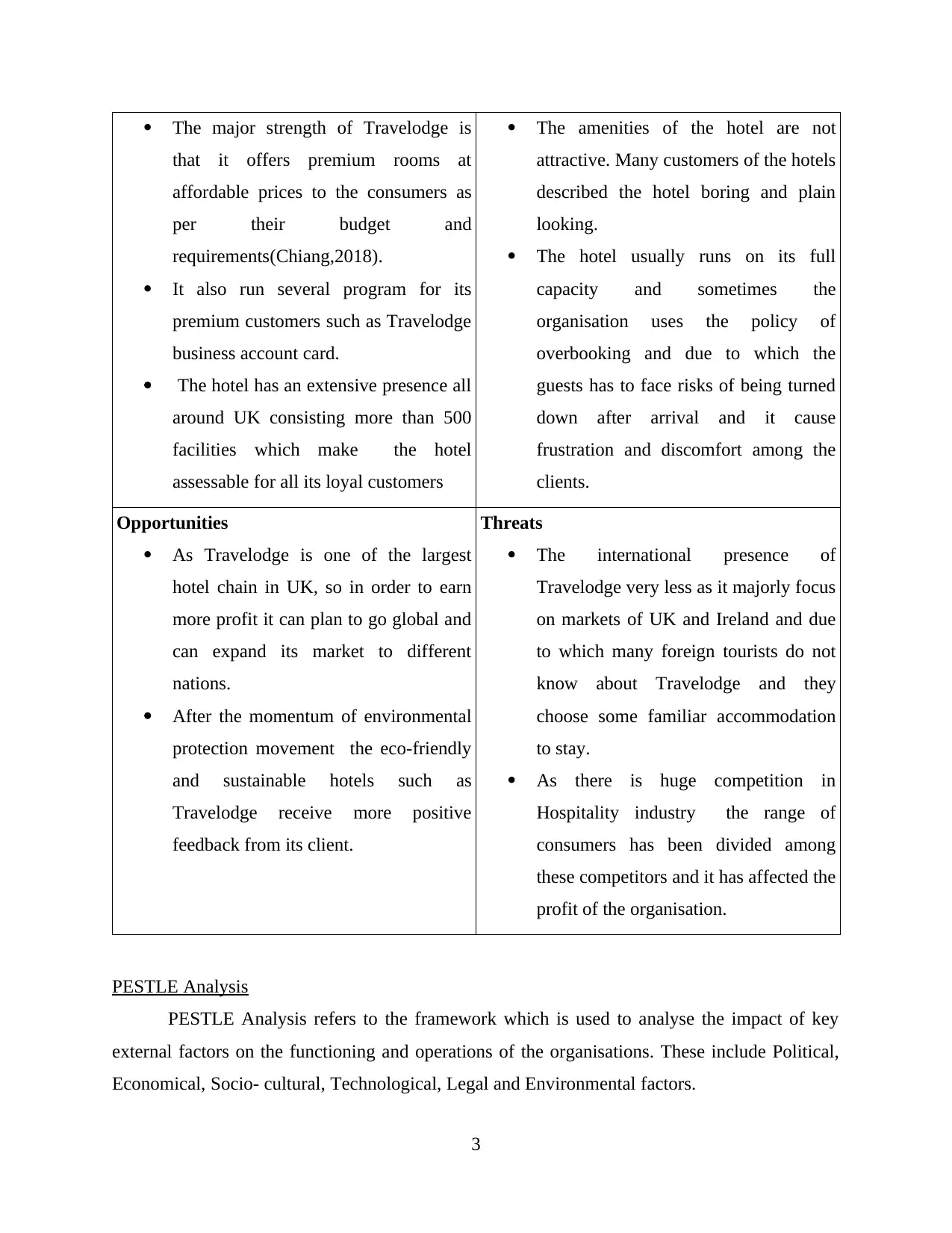
The major strength of Travelodge is
that it offers premium rooms at
affordable prices to the consumers as
per their budget and
requirements(Chiang,2018).
It also run several program for its
premium customers such as Travelodge
business account card.
The hotel has an extensive presence all
around UK consisting more than 500
facilities which make the hotel
assessable for all its loyal customers
The amenities of the hotel are not
attractive. Many customers of the hotels
described the hotel boring and plain
looking.
The hotel usually runs on its full
capacity and sometimes the
organisation uses the policy of
overbooking and due to which the
guests has to face risks of being turned
down after arrival and it cause
frustration and discomfort among the
clients.
Opportunities
As Travelodge is one of the largest
hotel chain in UK, so in order to earn
more profit it can plan to go global and
can expand its market to different
nations.
After the momentum of environmental
protection movement the eco-friendly
and sustainable hotels such as
Travelodge receive more positive
feedback from its client.
Threats
The international presence of
Travelodge very less as it majorly focus
on markets of UK and Ireland and due
to which many foreign tourists do not
know about Travelodge and they
choose some familiar accommodation
to stay.
As there is huge competition in
Hospitality industry the range of
consumers has been divided among
these competitors and it has affected the
profit of the organisation.
PESTLE Analysis
PESTLE Analysis refers to the framework which is used to analyse the impact of key
external factors on the functioning and operations of the organisations. These include Political,
Economical, Socio- cultural, Technological, Legal and Environmental factors.
3
that it offers premium rooms at
affordable prices to the consumers as
per their budget and
requirements(Chiang,2018).
It also run several program for its
premium customers such as Travelodge
business account card.
The hotel has an extensive presence all
around UK consisting more than 500
facilities which make the hotel
assessable for all its loyal customers
The amenities of the hotel are not
attractive. Many customers of the hotels
described the hotel boring and plain
looking.
The hotel usually runs on its full
capacity and sometimes the
organisation uses the policy of
overbooking and due to which the
guests has to face risks of being turned
down after arrival and it cause
frustration and discomfort among the
clients.
Opportunities
As Travelodge is one of the largest
hotel chain in UK, so in order to earn
more profit it can plan to go global and
can expand its market to different
nations.
After the momentum of environmental
protection movement the eco-friendly
and sustainable hotels such as
Travelodge receive more positive
feedback from its client.
Threats
The international presence of
Travelodge very less as it majorly focus
on markets of UK and Ireland and due
to which many foreign tourists do not
know about Travelodge and they
choose some familiar accommodation
to stay.
As there is huge competition in
Hospitality industry the range of
consumers has been divided among
these competitors and it has affected the
profit of the organisation.
PESTLE Analysis
PESTLE Analysis refers to the framework which is used to analyse the impact of key
external factors on the functioning and operations of the organisations. These include Political,
Economical, Socio- cultural, Technological, Legal and Environmental factors.
3
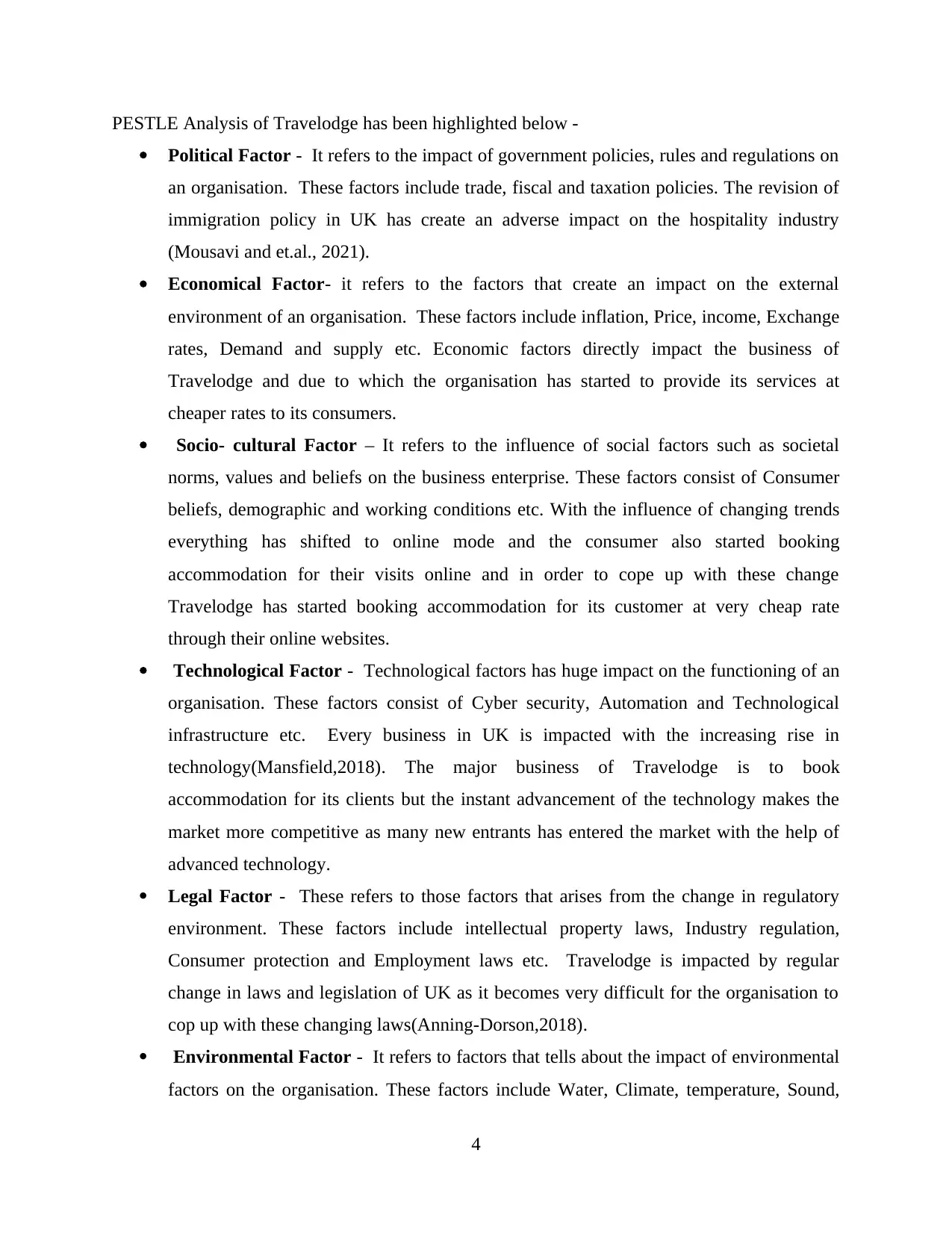
PESTLE Analysis of Travelodge has been highlighted below -
Political Factor - It refers to the impact of government policies, rules and regulations on
an organisation. These factors include trade, fiscal and taxation policies. The revision of
immigration policy in UK has create an adverse impact on the hospitality industry
(Mousavi and et.al., 2021).
Economical Factor- it refers to the factors that create an impact on the external
environment of an organisation. These factors include inflation, Price, income, Exchange
rates, Demand and supply etc. Economic factors directly impact the business of
Travelodge and due to which the organisation has started to provide its services at
cheaper rates to its consumers.
Socio- cultural Factor – It refers to the influence of social factors such as societal
norms, values and beliefs on the business enterprise. These factors consist of Consumer
beliefs, demographic and working conditions etc. With the influence of changing trends
everything has shifted to online mode and the consumer also started booking
accommodation for their visits online and in order to cope up with these change
Travelodge has started booking accommodation for its customer at very cheap rate
through their online websites.
Technological Factor - Technological factors has huge impact on the functioning of an
organisation. These factors consist of Cyber security, Automation and Technological
infrastructure etc. Every business in UK is impacted with the increasing rise in
technology(Mansfield,2018). The major business of Travelodge is to book
accommodation for its clients but the instant advancement of the technology makes the
market more competitive as many new entrants has entered the market with the help of
advanced technology.
Legal Factor - These refers to those factors that arises from the change in regulatory
environment. These factors include intellectual property laws, Industry regulation,
Consumer protection and Employment laws etc. Travelodge is impacted by regular
change in laws and legislation of UK as it becomes very difficult for the organisation to
cop up with these changing laws(Anning-Dorson,2018).
Environmental Factor - It refers to factors that tells about the impact of environmental
factors on the organisation. These factors include Water, Climate, temperature, Sound,
4
Political Factor - It refers to the impact of government policies, rules and regulations on
an organisation. These factors include trade, fiscal and taxation policies. The revision of
immigration policy in UK has create an adverse impact on the hospitality industry
(Mousavi and et.al., 2021).
Economical Factor- it refers to the factors that create an impact on the external
environment of an organisation. These factors include inflation, Price, income, Exchange
rates, Demand and supply etc. Economic factors directly impact the business of
Travelodge and due to which the organisation has started to provide its services at
cheaper rates to its consumers.
Socio- cultural Factor – It refers to the influence of social factors such as societal
norms, values and beliefs on the business enterprise. These factors consist of Consumer
beliefs, demographic and working conditions etc. With the influence of changing trends
everything has shifted to online mode and the consumer also started booking
accommodation for their visits online and in order to cope up with these change
Travelodge has started booking accommodation for its customer at very cheap rate
through their online websites.
Technological Factor - Technological factors has huge impact on the functioning of an
organisation. These factors consist of Cyber security, Automation and Technological
infrastructure etc. Every business in UK is impacted with the increasing rise in
technology(Mansfield,2018). The major business of Travelodge is to book
accommodation for its clients but the instant advancement of the technology makes the
market more competitive as many new entrants has entered the market with the help of
advanced technology.
Legal Factor - These refers to those factors that arises from the change in regulatory
environment. These factors include intellectual property laws, Industry regulation,
Consumer protection and Employment laws etc. Travelodge is impacted by regular
change in laws and legislation of UK as it becomes very difficult for the organisation to
cop up with these changing laws(Anning-Dorson,2018).
Environmental Factor - It refers to factors that tells about the impact of environmental
factors on the organisation. These factors include Water, Climate, temperature, Sound,
4
⊘ This is a preview!⊘
Do you want full access?
Subscribe today to unlock all pages.

Trusted by 1+ million students worldwide
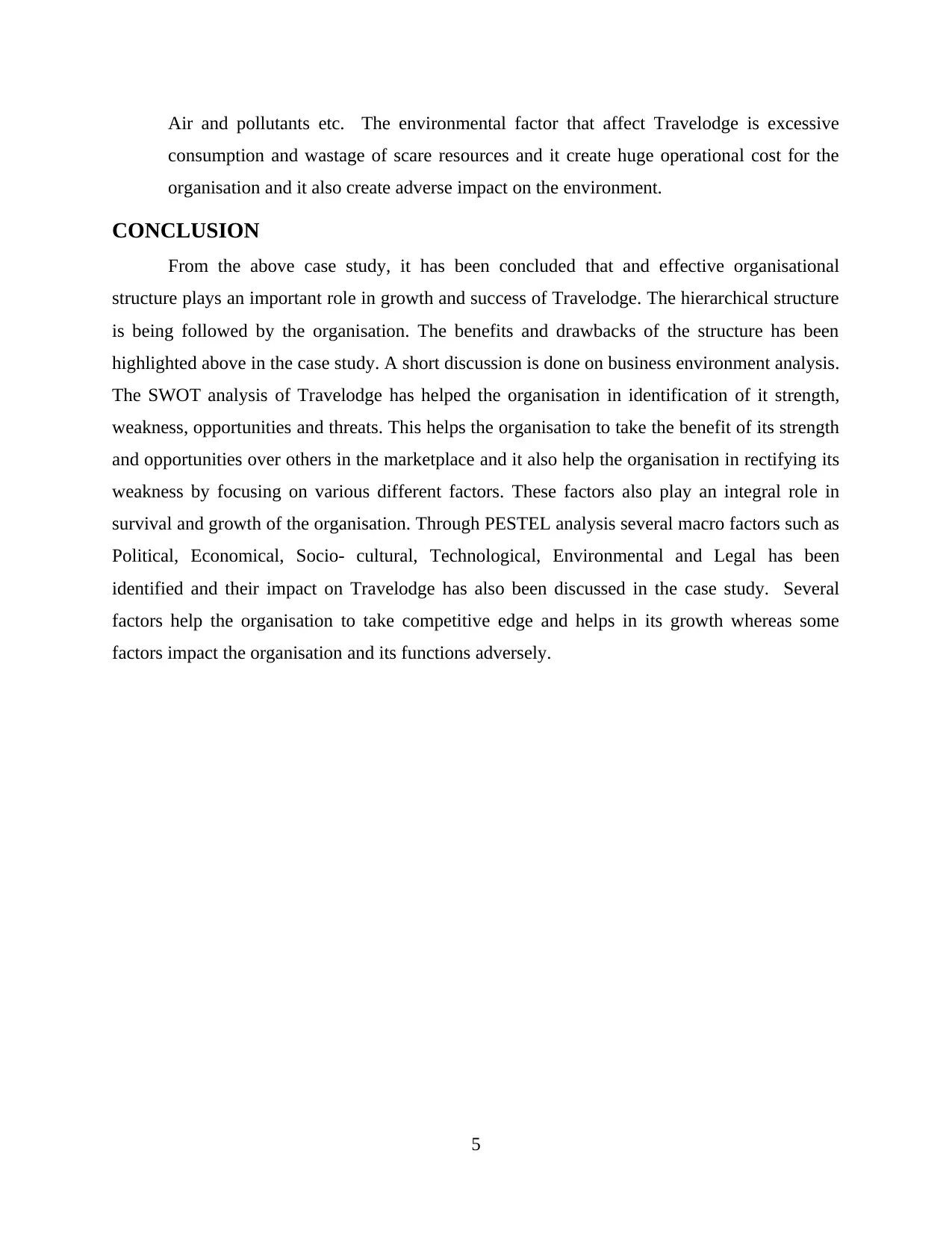
Air and pollutants etc. The environmental factor that affect Travelodge is excessive
consumption and wastage of scare resources and it create huge operational cost for the
organisation and it also create adverse impact on the environment.
CONCLUSION
From the above case study, it has been concluded that and effective organisational
structure plays an important role in growth and success of Travelodge. The hierarchical structure
is being followed by the organisation. The benefits and drawbacks of the structure has been
highlighted above in the case study. A short discussion is done on business environment analysis.
The SWOT analysis of Travelodge has helped the organisation in identification of it strength,
weakness, opportunities and threats. This helps the organisation to take the benefit of its strength
and opportunities over others in the marketplace and it also help the organisation in rectifying its
weakness by focusing on various different factors. These factors also play an integral role in
survival and growth of the organisation. Through PESTEL analysis several macro factors such as
Political, Economical, Socio- cultural, Technological, Environmental and Legal has been
identified and their impact on Travelodge has also been discussed in the case study. Several
factors help the organisation to take competitive edge and helps in its growth whereas some
factors impact the organisation and its functions adversely.
5
consumption and wastage of scare resources and it create huge operational cost for the
organisation and it also create adverse impact on the environment.
CONCLUSION
From the above case study, it has been concluded that and effective organisational
structure plays an important role in growth and success of Travelodge. The hierarchical structure
is being followed by the organisation. The benefits and drawbacks of the structure has been
highlighted above in the case study. A short discussion is done on business environment analysis.
The SWOT analysis of Travelodge has helped the organisation in identification of it strength,
weakness, opportunities and threats. This helps the organisation to take the benefit of its strength
and opportunities over others in the marketplace and it also help the organisation in rectifying its
weakness by focusing on various different factors. These factors also play an integral role in
survival and growth of the organisation. Through PESTEL analysis several macro factors such as
Political, Economical, Socio- cultural, Technological, Environmental and Legal has been
identified and their impact on Travelodge has also been discussed in the case study. Several
factors help the organisation to take competitive edge and helps in its growth whereas some
factors impact the organisation and its functions adversely.
5
Paraphrase This Document
Need a fresh take? Get an instant paraphrase of this document with our AI Paraphraser
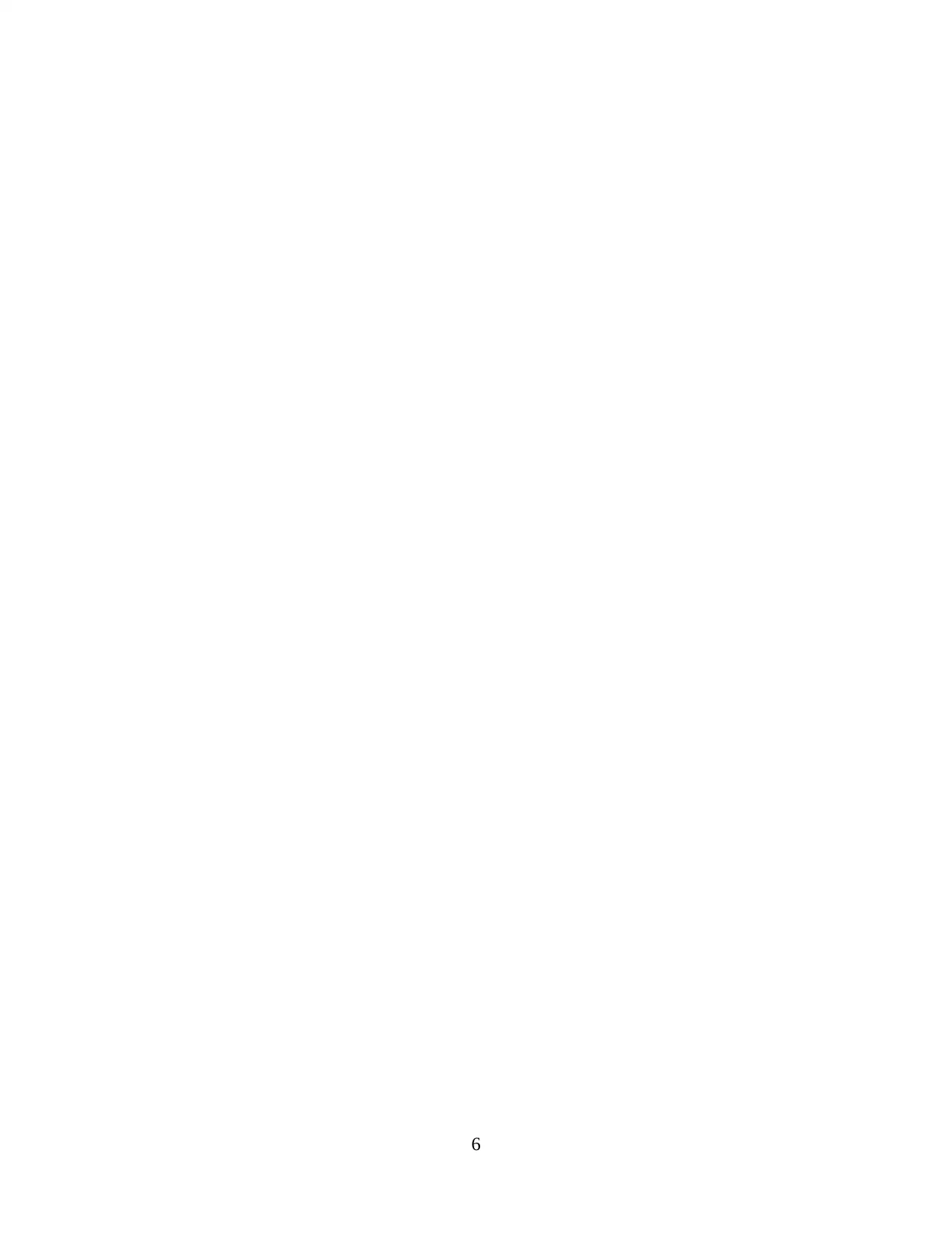
6
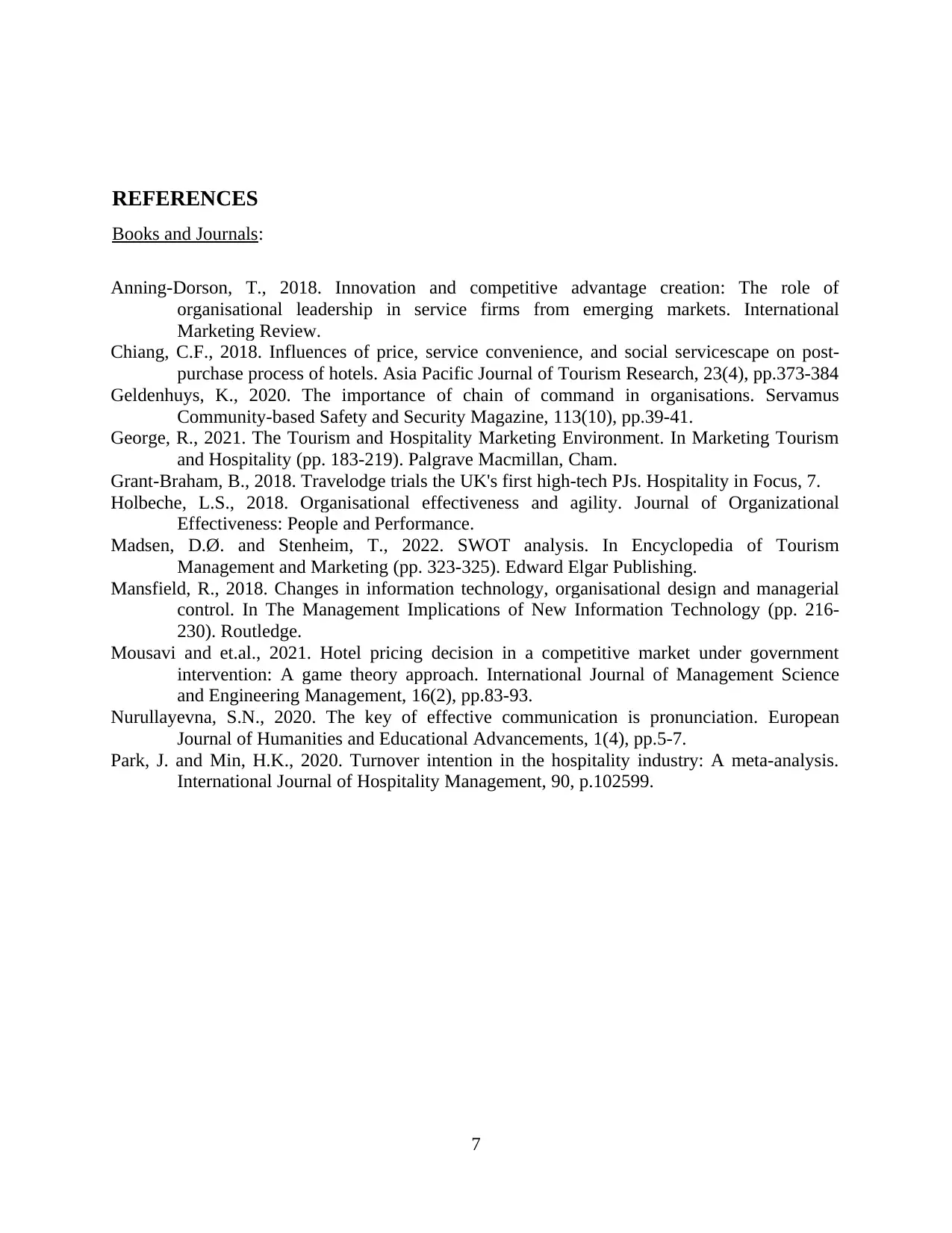
REFERENCES
Books and Journals:
Anning-Dorson, T., 2018. Innovation and competitive advantage creation: The role of
organisational leadership in service firms from emerging markets. International
Marketing Review.
Chiang, C.F., 2018. Influences of price, service convenience, and social servicescape on post-
purchase process of hotels. Asia Pacific Journal of Tourism Research, 23(4), pp.373-384
Geldenhuys, K., 2020. The importance of chain of command in organisations. Servamus
Community-based Safety and Security Magazine, 113(10), pp.39-41.
George, R., 2021. The Tourism and Hospitality Marketing Environment. In Marketing Tourism
and Hospitality (pp. 183-219). Palgrave Macmillan, Cham.
Grant-Braham, B., 2018. Travelodge trials the UK's first high-tech PJs. Hospitality in Focus, 7.
Holbeche, L.S., 2018. Organisational effectiveness and agility. Journal of Organizational
Effectiveness: People and Performance.
Madsen, D.Ø. and Stenheim, T., 2022. SWOT analysis. In Encyclopedia of Tourism
Management and Marketing (pp. 323-325). Edward Elgar Publishing.
Mansfield, R., 2018. Changes in information technology, organisational design and managerial
control. In The Management Implications of New Information Technology (pp. 216-
230). Routledge.
Mousavi and et.al., 2021. Hotel pricing decision in a competitive market under government
intervention: A game theory approach. International Journal of Management Science
and Engineering Management, 16(2), pp.83-93.
Nurullayevna, S.N., 2020. The key of effective communication is pronunciation. European
Journal of Humanities and Educational Advancements, 1(4), pp.5-7.
Park, J. and Min, H.K., 2020. Turnover intention in the hospitality industry: A meta-analysis.
International Journal of Hospitality Management, 90, p.102599.
7
Books and Journals:
Anning-Dorson, T., 2018. Innovation and competitive advantage creation: The role of
organisational leadership in service firms from emerging markets. International
Marketing Review.
Chiang, C.F., 2018. Influences of price, service convenience, and social servicescape on post-
purchase process of hotels. Asia Pacific Journal of Tourism Research, 23(4), pp.373-384
Geldenhuys, K., 2020. The importance of chain of command in organisations. Servamus
Community-based Safety and Security Magazine, 113(10), pp.39-41.
George, R., 2021. The Tourism and Hospitality Marketing Environment. In Marketing Tourism
and Hospitality (pp. 183-219). Palgrave Macmillan, Cham.
Grant-Braham, B., 2018. Travelodge trials the UK's first high-tech PJs. Hospitality in Focus, 7.
Holbeche, L.S., 2018. Organisational effectiveness and agility. Journal of Organizational
Effectiveness: People and Performance.
Madsen, D.Ø. and Stenheim, T., 2022. SWOT analysis. In Encyclopedia of Tourism
Management and Marketing (pp. 323-325). Edward Elgar Publishing.
Mansfield, R., 2018. Changes in information technology, organisational design and managerial
control. In The Management Implications of New Information Technology (pp. 216-
230). Routledge.
Mousavi and et.al., 2021. Hotel pricing decision in a competitive market under government
intervention: A game theory approach. International Journal of Management Science
and Engineering Management, 16(2), pp.83-93.
Nurullayevna, S.N., 2020. The key of effective communication is pronunciation. European
Journal of Humanities and Educational Advancements, 1(4), pp.5-7.
Park, J. and Min, H.K., 2020. Turnover intention in the hospitality industry: A meta-analysis.
International Journal of Hospitality Management, 90, p.102599.
7
⊘ This is a preview!⊘
Do you want full access?
Subscribe today to unlock all pages.

Trusted by 1+ million students worldwide
1 out of 9
Related Documents
Your All-in-One AI-Powered Toolkit for Academic Success.
+13062052269
info@desklib.com
Available 24*7 on WhatsApp / Email
![[object Object]](/_next/static/media/star-bottom.7253800d.svg)
Unlock your academic potential
Copyright © 2020–2025 A2Z Services. All Rights Reserved. Developed and managed by ZUCOL.





